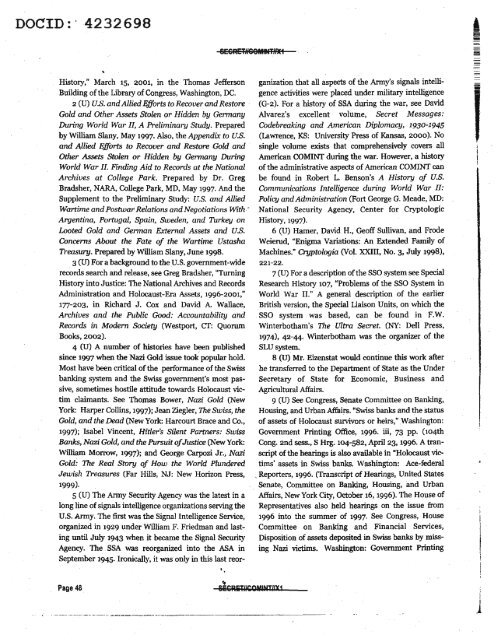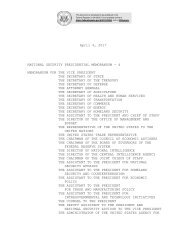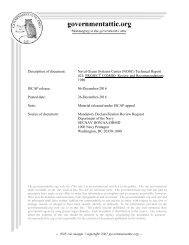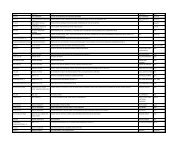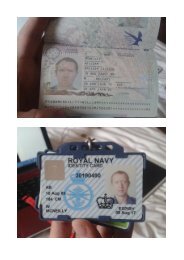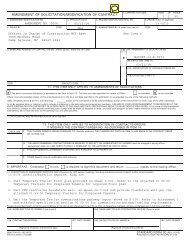government undersecretary
nsa-nazi-gold
nsa-nazi-gold
You also want an ePaper? Increase the reach of your titles
YUMPU automatically turns print PDFs into web optimized ePapers that Google loves.
DOCID:· 4232698<br />
SE6Ae:Fif69MIN:W:f.RE1<br />
History," March 15, 2001, in the Thomas Jefferson<br />
Building of the Library of Congress, Washington, DC.<br />
2 (U) U.S. and Allied Efforts to Recover and Restore<br />
Gold and Other Assets Stolen or Hidden by Germany<br />
During World War II, A Preliminary Study. Prepared<br />
by William Slany, May 1997. Also, the Appendix to U.S.<br />
and A,llied Efforts to Recover and Restore Gold and<br />
Other Assets Stolen or Hidden by Germany During<br />
World War II. Finding Aid to Records at the National<br />
Archives at College Park. Prepared by Dr. Greg<br />
Bradsher, NARA, College Park, MD, May 1997. And the<br />
Supplement to the Preliminary Study: U.S. and Allied<br />
Wartime and Postwar Relations and Negotiations With ·<br />
Argentina, Portugal, Spain, Sweden, and Turkey on<br />
Looted Gold and German External Assets and U.S.<br />
Concerns About the Fate of the Wartime Ustasha<br />
Treasury. Prepared by William Slany, June 1998 .<br />
. 3 (U) For a background to the U.S. <strong>government</strong>-wide<br />
records search and release, see Greg Bradsher, "Turning<br />
History into Justice: The National Archives and Records<br />
Administration and Holocaust-Era Assets, 1996-2001,"<br />
177-203, in Richard J. Cox and David A Wallace,<br />
Archives and the Public Good: Accountability and<br />
Records in Modern Society (Westport, Cf: Quorum<br />
Books, 2002).<br />
4 (U) A number of histories have been published<br />
since 1997 when the Nazi Gold issue took popular hold.<br />
Most have been critical of the performance of the Swiss<br />
banking system and the Swiss <strong>government</strong>'s most passive,<br />
sometimes hostile attitude towards Holocaust victim<br />
claimants. See Thomas Bower, Nazi Gold (New<br />
York: Harper Collins, 1997); Jean Ziegler, The Swiss, the<br />
Gold, and the Dead (New York: Harcourt Brace and Co.,<br />
1997); Isabel Vincent, Hitler's Silent Partners: Swiss<br />
Banks, Nazi Gold, and the Pursuit of Justice (New York:<br />
William Morrow, 1997); and George Carpozi Jr.; Nazi<br />
Gold: The Real Story of How the World Plundered<br />
Jewish Treasures (Far Hills, NJ: New Horizon Press,<br />
1999).<br />
5 (U) The Army Security Agency was the latest in a<br />
long line of signals intelligence organizations serving the<br />
U.S. Army. The first was the Signal Intelligence Service,<br />
organized in 1929 under William F. Friedman and lasting<br />
until July 1943 when it became the Signal Security<br />
Agency. The SSA was reorganized into the ASA in<br />
September 1945· Ironically, it was only in this last reorganization<br />
that all aspects of the Army's signals intelligence<br />
actiVities were placed under military intelligence<br />
(G-2). For a history of SSA during the war, see David<br />
Alvarez's excellent volume, Secret Messages:<br />
Codebreaking and American Diplomacy, 1930-1945<br />
(Lawrence, KS: University Press of Kansas, 2ooo). No<br />
single volume exists that comprehensively covers all<br />
American COMINT during the war. However, a history<br />
of the administrative aspects of American CO MINT can<br />
be found in Robert L . . Benson's A History of U.S.<br />
Communications Intelligence during World War II:<br />
Policy and Administration (Fort George G, Meade, MD:<br />
National Security Agency, Center for Cryptologic<br />
History, 1997).<br />
6 (U) Hamer, David H., Geoff Sullivan, and Frode<br />
Weierud, "Enigma Variations: An Extended Family of<br />
Machines." Cryptologia (Vol. XXIII, No. 3, July 1998),<br />
221-22.<br />
7 (U) For a description of the SSO system see Special<br />
Research History 107, "Problems of the SSO System in<br />
World War II." A general description of the earlier<br />
British version, the Special Liaison Units, on which the<br />
. SSO system was based, can be found in F.W.<br />
Winterbotham's The Ultra Secret. (NY: Dell Press,<br />
1974), 42-44. Winterbotham was the organizer of the<br />
SLU system.<br />
8 (U) Mr. Eizenstat would continue this work after<br />
he transferred to the Department of State as the Under<br />
Secretary of State for Economic, Business and<br />
Agricultural Affairs.<br />
9 (U) See Congress, Senate Committee on Banking,<br />
Housing, and Urban Affairs. "Swiss banks and the status<br />
of assets of Holocaust survivors or heirs," Washington:<br />
Government Printing Office, 1996. iii, 73 pp. (104th<br />
Cong. 2nd sess., S Hrg. 104-582, April 23, 1996. A transcript<br />
of the hearings is also available in "Holocaust victims'<br />
assets in Swiss banks. Washington: Ace-federal<br />
, Reporters, 1996. (Transcript of Hearings, United States<br />
Senate, Committee on Banking, Housing, and Urban<br />
Affairs, New York City, October 16, 1996). The House of<br />
Representatives also held hearings on the issue from<br />
1996 into the summer of 1997. See Congress, House<br />
Committee on Banking and Financial Services,<br />
Disposition of assets deposited in Swiss banks by missing<br />
Nazi victims. Washington: Government Printing<br />
-<br />
. I<br />
Page 48<br />
~<br />
&iGRi~OMINl'IX1<br />
r<br />
J


